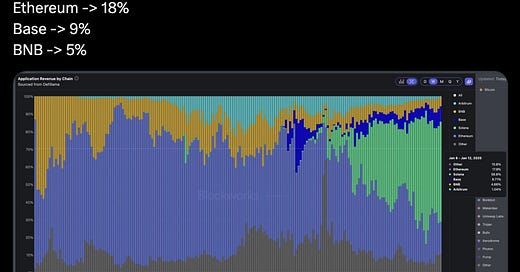Solana’s Hard Metrics and the Application Revenue Shift
Why the Industry Should Be Excited About Solana’s Recent Metrics Wins
There’s been a lot of noise recently about the fact that Solana is increasingly winning on many of the "hard" metrics that matter most in blockchain. These include:
Transaction Throughput: Consistently ranking among the fastest blockchains, handling thousands of transactions per second.
Transaction Costs: Maintaining some of the lowest fees in the industry.
Network Usage: High levels of on-chain activity, including daily active users and developer engagement.
Ecosystem Growth: A rapidly expanding roster of applications across DeFi, NFTs, gaming, and more.
Energy Efficiency: Operating with one of the lowest energy footprints among major blockchains.
But the metric that excites me most isn’t about raw throughput or user counts. It’s share of application revenue and the ratio of application revenue to chain revenue. This metric reveals where value is being captured and by whom—and it tells an important story about where Solana’s vision is succeeding.
A Vision for Blockspace at Its Physical Limits
From the beginning, the vision for Solana was to push the cost and latency of writing to blockspace to their physical limits. By reducing the cost of transactions and making blockspace as abundant as possible, Solana creates an environment where applications, not the chain itself, are the primary beneficiaries of value capture.
This vision is playing out. Developers on Solana are seeing growing revenue streams, while the chain remains an efficient, low-cost platform for transactions. By design, Solana’s architecture ensures that as applications generate value, they capture a significant share of that value rather than funneling it disproportionately to the underlying infrastructure.
Why This Matters
The industry has spent years fixated on the idea of blockchains as economic engines in themselves. But Solana’s model flips this on its head: the blockchain becomes a substrate for applications to thrive. This aligns closely with how successful tech platforms have operated historically—by empowering developers to create value at the edges.
When the ratio of application revenue to chain revenue skews heavily in favor of applications, it signals a thriving ecosystem. Applications aren’t just surviving—they’re generating real value for users and developers alike. This dynamic is what will drive long-term adoption, innovation, and sustainability for Solana and its ecosystem.
What’s Next?
As Solana continues to scale, the opportunity for applications to grow alongside it will only expand. The low costs and high performance of the network set the stage for entirely new categories of applications that weren’t feasible before. From microtransactions to real-time gaming economies, the possibilities are immense.
This isn’t just a win for Solana; it’s a win for the entire industry. If we’re serious about onboarding billions of users into Web3, we need models that prioritize accessibility, scalability, and application-layer innovation. Solana is proving that this vision is not only possible but already happening.



